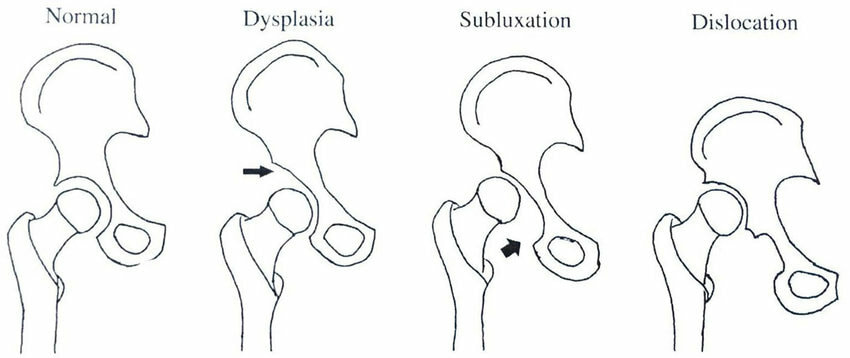|
Most people understand joint dislocations. But subluxations, or partial dislocations, are a bit different. As a myotherapist, I see plenty of subluxations and related injuries every week. So let’s look at why subluxations aren’t quite dislocations, and what you can do about them! What is a subluxation? Unlike a dislocation, a subluxation is a partial displacement of the joint. With a dislocation, the bone is completely out of the joint it belongs to. But with a subluxation, the bone is only partly out. Just because it is not a full dislocation doesn’t mean that it won’t hurt! Subluxation can still be painful, as the joint is being wrenched out of its usual spot. It can also leave you at higher risk of chronic pain if the joint isn’t rehabilitated after the injury. In the image above, we're looking at the ball and socket joint of the hip. The Normal hip joint shows the ball of the femur (thigh bone) sitting neatly inside the socket joint of the pelvis. In Dysplasia, the shape of the socket is not correctly formed so the socket doesn't snugly hold the ball of the femur. In Subluxation, the ball of the femur has partially slid out from the socket, and while its still almost in the right spot, it likely won't move smooth and painfree like the normal hip. And in the Dislocation, the ball of the femur has entirely moved out of the socket.
Why do joints sublux? It is easier for a joint to sublux than it is to dislocate. That being said, if you have full strength and integrity in your joints, it will take a high-impact injury to sublux a joint. This is usually something like a fall, car accident or a sports injury. However, some people are at a higher risk due to weak, unstable or unusually shaped joints. A previous history of dislocation or subluxation can weaken the joint and make it more prone to a sublux. People with hypermobile joints can sublux joints with minimal force, because the ligaments (connective tissue that holds the joint together) are more elastic than they should be. This can lead to the person being very flexible but also more prone to subluxations – some of my more hypermobile clients can sublux joints while walking, sitting, or even sleeping! You can also have variations in the shape of your hip or shoulder joints that make it easier to sublux. Hip dysplasia is one common variation that increases the risk of subluxing a hip joint, like in the image above. Joints at risk of subluxation In the clinic, I’ve seen almost every subluxation possible, thanks to my hypermobile clients! But there are several joints that are easier to sublux due to their location and structure:
If you have hypermobile joints, you may be at risk of subluxing other joints like ribs, jaw and collarbone. How is a subluxed joint rehabilitated? It can depend on the type of subluxation, and how it occurred. If it was due to high-impact trauma, there’s likely to be a decent amount of joint damage that needs attention. It could take weeks before the pain subsides enough to focus on rehabilitation. But if the sublux occurred due to hypermobility or dysplasia, it might just need a little TLC for a week or two. After that, the focus will be on building up the muscles that support the joint to reduce the risk of recurrence. Either way, the focus for rehabilitating the joint will include stabilising it, minimising any symptoms, and rebuilding the strength and integrity. What can a myotherapist do for subluxations? If you’re dealing with a subluxed joint (or multiple!), I’m here to help. Let’s look at how myotherapy can help with subluxations:
So don’t sit at home and feel sore after a joint has subluxed. Come see your favourite myotherapist. We’ll have you feeling better in no time! Click here to book an appointment. Last week, I shared a bit about four interesting studies that look at pain. But I couldn’t stop at just four! So today, we’ll look at another four of the latest studies around how pain works, and what we can do about it. Mindful people experience less pain
Some people just don’t seem to experience pain as much as others. One study has suggested that part of the reason why is mindfulness. What is mindfulness? It’s being in the present moment, rather than the past or future. When you are mindful, you are an observer of your experience rather than reacting with emotions and judgements. 76 volunteers with varying levels of innate mindfulness took part. Their brains were scanned as they were exposed to painful heat of around 49 degrees Celcius (aka a typical Aussie summer day, right?) The scans reveal that people who were more mindful did not activate an area of the brain called the posterior cingulate cortex as much as those who were less mindful. Those who reported high pain levels had a greater activation of the cortex. The researchers concluded that mindful people are less caught up in the experience of pain. You can’t change your in-born level of mindfulness, but there is other research that suggests that mindfulness practices can help with pain. This might explain why! Being hungry shuts off perception of pain Pain is a valuable experience for the human body. Without it, we would damage our bodies without realising the consequences! But chronic pain can lead to lethargy and exhaustion. So what if nature gave us a way to suppress chronic pain temporarily? Turns out, nature might have done just that. Researchers have pinpointed a group of 300 brain cells that prioritise hunger over chronic pain. They found that hungry mice would respond to acute pain, but were less fussed about longer-term inflammatory pain compared to well-fed mice. Further experiments revealed that the neurotransmitter NPY can block the inflammatory pain response when needed. This is a new area for more research, but it could reveal ways to inhibit chronic pain without shutting off acute pain. 'Tuning' the brain can alleviate pain Previous research has found that alpha waves are associated with relief of pain from a placebo effect, and can influence how different parts of the brain process pain. So researchers looked into whether ‘tuning’ the brain to alpha waves can reduce pain. The experiment involved flashing light or playing noise that were in the alpha range. Both of these interventions significantly reduced intensity of pain. The researchers are now looking into how effective these are for different pain conditions. It’s early days. But soon, you could be watching YouTube videos or listening to meditations in the alpha range that are able to reduce your pain! Does an exploding brain network cause chronic pain? Hyperactive brain networks could be why people with fibromyalgia experience hypersensitivity. Their brain networks are primed to react with rapid and system-wide responses to minor in response to minor changes. This is known as explosive synchronisation. The researchers looked at the electrical activity of women with fibromyalgia. There was a strong correlation between the hypersensitivity of the brain and the intensity of pain reported by the women. This suggests that a chronic pain brain is electrically unstable and sensitive. So the next time someone asks you about your fibromyalgia, tell them it’s your exploding brain network! In case you haven’t figured out, supporting people with chronic pain is my passion. If you’re looking to work with a health professional who will work with you on your journey to recovery, book a myotherapy appointment today. It’s no secret that I’m a bit of a research geek. Scientists everywhere are exploring the experience of pain and how we can alleviate it. So I thought I’d share some of the most recent findings about pain. Some of these you might be able to apply in your daily life. Some you might like to share with your healthcare providers. And some are just interesting to know! Men and women remember pain differently
Scientists have theorised for years that chronic pain is related to memories of earlier pain. One team has found that men remembered a previous painful experience quite clearly. This made them hypersensitive when they were returned to the location of that experience. On the other hand, women were less stressed about their experience. The same researchers did the same experiment on mice, and ‘blocked’ the memories of male mice. When they ran the experiment with the blocked mice, they did not show signs of being stressed by the previous pain. The brain cells that make pain unpleasant If you step on a sharp object, your nerve cells in the brain tell you two things – there’s a piercing sensation in your foot, and that it’s not a nice feeling. But a team of scientists have discovered the brain cells that tell you all about that not-so-nice feeling – these brain cells are responsible for the negative emotions of pain. In an experiment with mice, they were able to identify a group of neurons in the basolateral area of the amygdala (often called the fear centre of the brain). When the mice experienced pain, these neurons would fire. But when this bundle of neurons was turned off, the mice didn’t experience the discomfort of pain. They were still able to feel and respond to sensations, but pain was no longer unpleasant for them. Pain as a self-fulfilling prophecy Have you ever flinched at something that you expect to hurt? The latest research suggests that you probably will feel pain, even if it doesn’t cause pain. Say what? If you expect pain, your brain will respond to that pain. Researchers scanned the brain of people who were exposed to low heat and high, painful heat. The participants were shown cues to suggest whether the heat was going to be low or high. When the heat was applied, they rated their pain. But what they didn’t realise was that the cues didn’t always correlate to the heat they received. When they expected high heat, brain regions around threat and fear were activated while they waited. When the heat was applied, there was more activity in the pain regions of the brain – even if it was a low heat. This may be part of why chronic pain lasts long after the damage to tissue has healed. Genes associated with chronic back pain discovered Chronic back pain is actually the number one cause of years lived with disability world-wide. So scientists are looking at all of the factors that might contribute to it. Recently, researchers have uncovered three gene variations that are associated with chronic back pain. The study looked at the genes of 158,000 people, including 29,000 that had chronic back pain. Then they looked for the genes that popped up for those with chronic back pain. One gene variant, SOX5, is involved with development of the body in the womb. If it’s turned off, it causes defects in cartilage and bone formation. A second gene that was already associated with disc herniation was linked to chronic back pain. The third was a gene that plays a role in the development of the spinal cord. This might not cure your chronic back pain, but it does help researchers to pinpoint the structures and processes involved. In the meantime, make sure you get yourself booked for a myotherapy session! There were so many interesting research papers that I have pt 2 coming up next week! If you don’t want to miss out, make sure you’re following my Facebook page. There, I share tips, info and insights into chronic pain management and myotherapy. |
Meet Our Team
We have a team of great practitioners available 7 days a week at our Rowville clinic. Archives
July 2024
Categories
All
|
Got a question about Myotherapy?
Contact Mel by phone, email or Facebook
|
Simple Wellness Myotherapy & Remedial Massage Clinic
Shop 12B 150 Kelletts Rd Rowville VIC 3178 |
Phone us on
03 8204 0970 |




 RSS Feed
RSS Feed